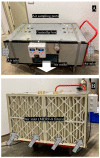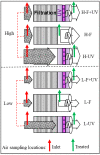Evaluation of an Air Cleaning Device Equipped with Filtration and UV: Comparison of Removal Efficiency on Particulate Matter and Viable Airborne Bacteria in the Inlet and Treated Air
- PMID: 36498208
- PMCID: PMC9735963
- DOI: 10.3390/ijerph192316135
Evaluation of an Air Cleaning Device Equipped with Filtration and UV: Comparison of Removal Efficiency on Particulate Matter and Viable Airborne Bacteria in the Inlet and Treated Air
Abstract
Since the COVID-19 pandemic, improving indoor air quality (IAQ) has become vital for the public as COVID-19 and other infectious diseases can transmit via inhalable aerosols. Air cleaning devices with filtration and targeted pollutant treatment capabilities can help improve IAQ. However, only a few filtration/UV devices have been formally tested for their effectiveness, and little data is publicly available and UV doses comparable. In this research, we upgraded a particulate matter (PM) air filtration prototype by adding UV-C (germicidal) light. We developed realistic UV dose metrics for fast-moving air and selected performance scenarios to quantify the mitigation effect on viable airborne bacteria and PM. The targeted PM included total suspended particulate (TSP) and a coarse-to-fine range sized at PM10, PM4, PM2.5, and PM1. The PM and viable airborne bacteria concentrations were compared between the inlet and outlet of the prototype at 0.5 and 1.0 m3/s (low and high) air flow modes. The upgraded prototype inactivated nearly 100% of viable airborne bacteria and removed up to 97% of TSP, 91% of PM10, 87% of PM4, 87% of PM2.5, and 88% of PM1. The performance in the low flow rate mode was generally better than in the high flow rate mode. The combination of filtration and UV-C treatment provided 'double-barrier' assurance for air purification and lowered the risk of spreading infectious micro-organisms.
Keywords: UV disinfection; UV254; UVGI; air pollution control; biosecurity; disease control; indoor air quality; occupational health; ultraviolet light.
Conflict of interest statement
The authors declare no conflict of interest.
Figures







References
-
- Guidelines for Environmental Infection Control in Health-Care Facilities. [(accessed on 10 August 2022)]; Available online: https://www.cdc.gov/infectioncontrol/pdf/guidelines/environmental-guidel....
-
- Kim H.-J., Han B., Kim Y.-J., Jeong C.-S., Lee S.-H. A simple and efficient method for evaluating air-cleaning performance against airborne allergen particles. Build. Environ. 2013;60:272–279. doi: 10.1016/j.buildenv.2012.11.002. - DOI
MeSH terms
Substances
Grants and funding
LinkOut - more resources
Full Text Sources
Other Literature Sources
Medical
Miscellaneous

